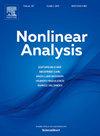基于拓扑度方法的有限图分数阶chen - simons - higgs模型
IF 1.3
2区 数学
Q1 MATHEMATICS
引用次数: 0
摘要
研究了连通有限图上的分数阶Chern-Simons-Higgs模型(−Δ)su=λeu(eu−1)2p+1+ f0,其中(−Δ)s为分数阶拉普拉斯算子,s∈(0,1),λ为实数,p为非负整数,f为图上的函数。本文主要研究由热核定义的分数阶拉普拉斯算子,并采用拓扑度理论作为主要工具。首先,我们证明了分数阶chen - simons - higgs模型的所有解是一致有界的。其次,我们通过逐个讨论同伦方程解的存在性来计算拓扑度。作为结果,我们得到了连通有限图上分数阶chen - simons - higgs模型的存在性结果。本文章由计算机程序翻译,如有差异,请以英文原文为准。
Fractional Chern–Simons–Higgs models on finite graphs via a topological degree approach
We investigate the fractional Chern–Simons–Higgs models of the form on a connected finite graph, where is the fractional Laplace operator, , is a real number, is a non-negative integer, and is a function on the graph. We focus on the fractional Laplace operator defined with heat kernels and employ the topological degree theory as our main tool. First, we prove that all solutions to fractional Chern–Simons–Higgs models are uniformly bounded. Second, we calculate the topological degree by discussing the existence of the solution to a homotopy equation case by case. As consequences, we obtain the existence results for the fractional Chern–Simons–Higgs models on a connected finite graph.
求助全文
通过发布文献求助,成功后即可免费获取论文全文。
去求助
来源期刊
CiteScore
3.30
自引率
0.00%
发文量
265
审稿时长
60 days
期刊介绍:
Nonlinear Analysis focuses on papers that address significant problems in Nonlinear Analysis that have a sustainable and important impact on the development of new directions in the theory as well as potential applications. Review articles on important topics in Nonlinear Analysis are welcome as well. In particular, only papers within the areas of specialization of the Editorial Board Members will be considered. Authors are encouraged to check the areas of expertise of the Editorial Board in order to decide whether or not their papers are appropriate for this journal. The journal aims to apply very high standards in accepting papers for publication.

 求助内容:
求助内容: 应助结果提醒方式:
应助结果提醒方式:


